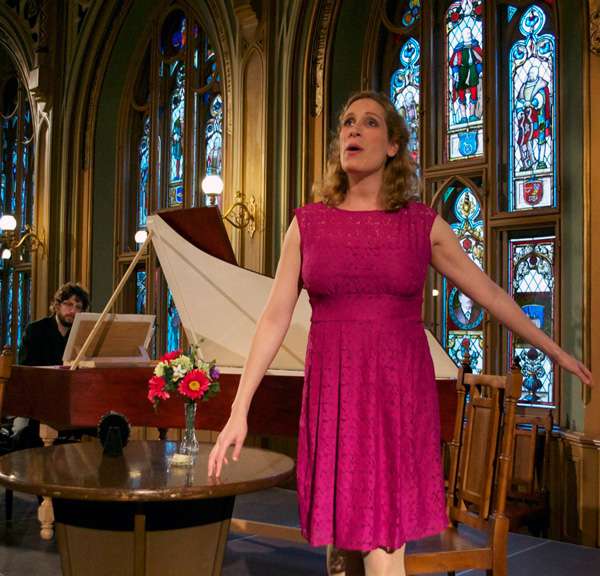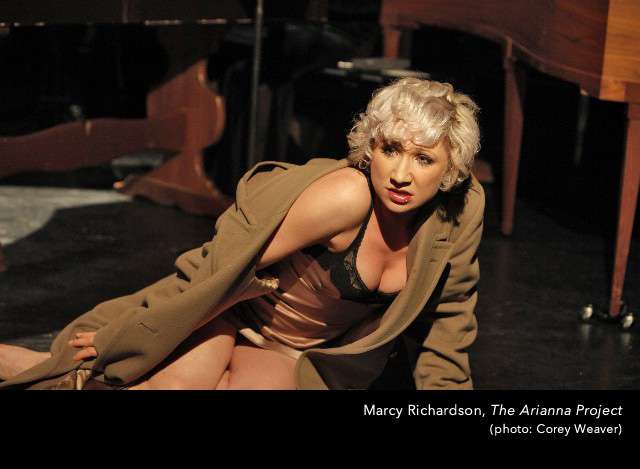|
Back
The Story of a Woman Scorned New York
Le Poisson Rouge
01/14/2013 -
Claudio Monteverdi: Il lamento d’Arianna
Franz Josef Haydn: Arianna a Naxos
Alessandro Scarlatti: L’Arianna
Wolfgang Amadeus Mozart: Fantasia in D minor, K. 397
Arcangelo Corelli: Sonata da camera in C minor, Opus 4, Nr. 11
Maeve Höglund, Marcy Richardson (Sopranos), Amanda Keil (Artistic Director/Mezzo-soprano), Sylvia Berry (Fortepiano and harpsichord), Abigail Karr, Vita Wallace (Violins), Motomi Iragashi (Viola da gamba), Grant Herreid (Theorbo)
Beth Greenberg (Stage Director), Tess James (Lighting Designer)

A. Keil (© Michael Jo)
The concept of “The Arianna Project” was probably a promising one. Find a Greek myth where the heroine represents that most common of female misfortunes–the woman spurned after seduction–and then sing three arias from three different composers representing that woman.
Well, Ariadne (or Arianna) is hardly the perfect heroine, and the three arias were not the perfect subject for the hour’s entertainment at Poisson Rouge last night. Actually a blackmailer, she refused to help Theseus find his way to the minotaur’s lair unless he married her. One doesn’t blame him for leaving her on a deserted isle. It saved divorce proceedings later on.
Nor, with one notable exception, were these three arias varied enough, save for the Baroque and Classical specialist.
But the three singers of Musica Nueva, (subtitled “A New Look at Early Music”) did try their best. They needed two props. One was a puzzling two-foot-high book, the pages of which were turned by various heroines when not singing. The other was obvious: an equally large bed, upon which each singer in turn flopped down, writhed, sung running scales and trills lying on their stomachs or backs, lifting their legs, rising up and gesturing the way 18th Century women (or more likely boys or castrati) would gesture.
I’m not certain if they were looking for authenticity in gestures, or (since audience group laughed with delight), they were parodying these Sturm und Drang exaggerations. The gestures did seem, quite authentic. But after a few moments, one got the idea, that they were emotional wrecks, left on the shore of a remote island (named after the record company Naxos), yearning for their seducer cum husband.
The three arias were not translated, but the Italian was obvious, once one knew the story. Artistic Director Amanda Keil was the mezzo-soprano who produced the Ariadne of Haydn’s cantata (more appropriately, perhaps, a scena), giving a notable purity to the lament. As with the other singers, as she threw herself about that bed, it was a contrivance. (Methought that Theseus had tied her up on the seashore, but this was the “new look to early music”). But Ms. Keil has a purity of line which retained the classic emotional feeling of old Haydn.
The first aria, sung by Maeve Höglund is, for good reason, the most popular in all early opera. In fact, Monteverdi’s Il lamento d’Arianna is rightly compared to Dido’s lament from the Purcell opera. I personally prefer the former, its emotional content so personally (rather than operatically) passionate. Soprano Höglund is well known, both at Poisson Rouge and Gotham Opera, for her Baroque work, and her voice here showed the effortless beauty of the music. Yet here again, Monteverdi’s emotional pull is so gut-grabbing, so fervent, that the body and hand movements were superfluous. In the middle of the opera on an opera stage, those movements would be appropriate (and they certainly wowed the Mantua audiences four centuries ago). Here, it was little embarrassing.

M. Richardson (© Corey Weaver)
Marcy Richardson was dramatically by far the most effective in her Scarlatti scena. Nothing was embarrassing as she raged about the stage, summoning sea monsters, going ballistic over Theseus (the Italian translated, in her voice, to “I’ll murder that *&^ s.o.b.”) and finally, joined by the other singers, happily transported to heaven by Bacchus.
The arias were accompanied by a very discreet music ensemble, starting with the appropriate Mozart Fantasia, the first section of which could well introduce these legends. A lifeless Corelli sonata was the interlude to fill out the hour.
One has every respect for Musica Nuova’s attempt to enliven the three arias, but the songs do speak for themselves. One night ago, Elliott Carter celebrants rejoiced–but newcomers were equally seduced. Last night, Baroquians might have enjoyed the songs, but others in the audience might well have felt a torport.
And frankly, after the performance, I walked home and put on a recording to Richard’s Strauss’s own opera-within-an-opera, Ariadne auf Naxos. That music, written a century ago, needs no “new look.” It speaks, quite perfectly for itself.
Harry Rolnick
|